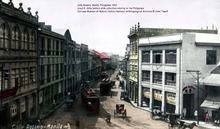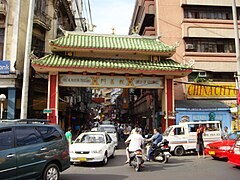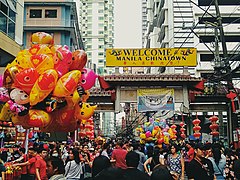Binondo
This article needs additional citations for verification. (December 2023) |
Binondo | |
|---|---|
Constituent and Central Business District of Manila | |
| Other transcription(s) | |
| • Chinese | 岷倫洛 |
 Binondo skyline at night | |
| Nickname: | |
 Location within Manila | |
| Country | Philippines |
| Region | National Capital Region |
| City | Manila |
| Congressional District | Part of 3rd District of Manila |
| Barangays | 10 |
| Founded | 1594 |
| Founded by | Luis Pérez Dasmariñas |
| Area | |
• Total | 0.66 km2 (0.26 sq mi) |
| Population (2020[1]) | |
• Total | 20,491 |
| • Density | 31,000/km2 (79,000/sq mi) |
| Time zone | UTC+08:00 (Philippine Standard Time) |
| Zip codes | 1006 |
| Area codes | 2 |
| Languages | Hokkien Tagalog Mandarin |
| Binondo | |||||||||||||||||||||||||
|---|---|---|---|---|---|---|---|---|---|---|---|---|---|---|---|---|---|---|---|---|---|---|---|---|---|
| Traditional Chinese | 岷倫洛區 | ||||||||||||||||||||||||
| Simplified Chinese | 岷伦洛区 | ||||||||||||||||||||||||
| |||||||||||||||||||||||||
Binondo (Chinese: 岷倫洛; pinyin: Mínlúnluò; Pe̍h-ōe-jī: Bîn-lûn-lo̍h) is a district in Manila and is referred to as the city's Chinatown.[2] Its influence extends beyond to the places of Quiapo, Santa Cruz, San Nicolas and Tondo. It is the oldest Chinatown in the world, established in 1594[3][4][5][6] by the Spaniards as a settlement near Intramuros but across the Pasig River for Catholic Chinese; it was positioned so that the colonial administration could keep a close eye on their migrant subjects.[7] It was already a hub of Chinese commerce even before the Spanish colonial period. Binondo is the center of commerce and trade of Manila, where all types of business run by Chinese Filipinos thrive.
Noted residents include Saint Lorenzo Ruiz, the Filipino protomartyr, and Venerable Mother Ignacia del Espiritu Santo, founder of the Congregation of the Religious of the Virgin Mary.
Etymology
[edit]Numerous theories on the origin of the name "Binondo", and that of "Tondo", its neighboring district, have been put forward. Philippine National Artist Nick Joaquin suggested that the names might have been derived from the archaic spelling of the Tagalog term "binondoc" (modern orthography: binundók), or mountainous, referring to Binondo's originally hilly terrain.[8][9] French linguist Jean-Paul Potet, however, has suggested that the river mangrove (Aegiceras corniculatum), which at the time was called "tundok" ("tinduk-tindukan" today), is the most likely origin of the term, with the 'Bi-" prefix in "Binondo" indicating Binondo's location relative to Tondo.[10]
History
[edit]

Founded in 1594, Binondo was created by Spanish Governor Luis Pérez Dasmariñas as a permanent settlement for Chinese immigrants (the Spanish called the Chinese sangleys) who converted to Catholicism. It was across the river from the walled city of Intramuros, where the Spaniards resided. Originally it was intended to replace the Parian near Intramuros, where Sangley Chinese merchants and artisans were first confined. The Spanish gave a land grant for Binondo to a group of Chinese merchants and artisans in perpetuity, tax-free and with limited self-governing privileges. The area also served as a midpoint in between Parián (modern-day Arroceros Urban Forest Park) and San Nicolas, since way before the Spanish conquest of Manila in the Battle of Manila (1570), a Sangley Chinese community had already settled in Baybay (former name of San Nicolas, Manila) near Tondo on the north bank of the Pasig river directly on Binondo's west.[11]

The Spanish Dominican fathers made Binondo their parish and succeeded in converting many of the residents to Catholicism. Binondo soon became the place where Chinese immigrants converted to Catholicism, intermarried with indigenous Filipino women and had children, who became the Chinese mestizo community. Over the years, the Chinese mestizo population of Binondo grew rapidly. This was caused mainly because the lack of Chinese immigrant females and the Spanish officials' policy of expelling or killing (in conflicts) Chinese immigrants who refused to convert.
In 1603, a Chinese revolt took place led by Juan Suntay, a wealthy Chinese Catholic. It was put down by joint Spanish and Filipino forces led by Luis Pérez Dasmariñas. In the aftermath most of the 20,000 Chinese that composed the colony were killed. The revolt took place right after a visit to Manila by three official Chinese representatives who disclosed they were searching for "a mountain of gold". This strange claim prompted the Spanish to conclude that there was an imminent invasion from China in the making. At the time the local Chinese outnumbered the Spaniards by twenty to one, and Spanish authorities feared that they would join the invading forces.[12] The Chinese afterward played down those events in an attempt to preserve their commercial interests. In 1605, a Fukien official issued a letter claiming that the Chinese who had participated in the revolt were unworthy of China's protection, describing them as "deserters of the tombs of their ancestors".[13]
During the brief British occupation of Manila, between 1762 and 1764, Binondo was damaged during the capture of the city. The new governor of Manila, Dawsonne Drake, formed a war council which he termed the "Chottry Court". Drake imprisoned several Manilans on charges known "only known to himself", according Captain Thomas Backhouse, who denounced Drake's court as a sham.[14] Binondo became the main center for business and finance in Manila for the ethnic Chinese, Chinese mestizos and Spanish Filipinos. During the Spanish colonial period, many esteros (canals) were constructed in the Binondo area, from where they entered the Pasig River. Among the many who married at the historic Binondo Church was Andres Bonifacio in 1895, who became a hero of the Philippine Revolution.
Before World War II, Binondo was the center of a banking and financial community which included insurance companies, commercial banks and other financial institutions from Britain and the United States. These banks were located mostly along Escólta, which used to be called the "Wall Street of the Philippines".
After the war and new development, most businesses began to relocate to the newer Zobel de Ayala family-led area of Makati. During the financial crisis of the early 1980s under the presidency of Ferdinand Marcos, it had the moniker "Binondo Central Bank",[15] as the local Chinese businessmen engaged in massive black market trading of US dollars, which often determined the national peso-dollar exchange rate. Given its rich historical and financial significance, Binondo is said to have one of the highest land values nationwide.
The Binondo was plot setting for the episode "Mata" and "Mukha" of the 2010 horror film Cinco. The Binondo was commercial setting of Solmux spitting of the worms bacteria on the road.
Barangays
[edit]The most populated barangay in Binondo is Barangay 293.
Zone 27: 287, 288, 289, 290, 291
Zone 28: 292, 293, 294, 295, 296
| Barangay | Land area (km2) | Population (2020 census) |
|---|---|---|
| Zone 27 | ||
| Barangay 287 | 0.1277 km2 | 2,546 |
| Barangay 288 | 0.03718 km2 | 2,538 |
| Barangay 289 | 0.04449 km2 | 1,017 |
| Barangay 290 | 0.05753 km2 | 1,093 |
| Barangay 291 | 0.1064 km2 | 2,279 |
| Zone 28 | ||
| Barangay 292 | 0.05359 km2 | 2,846 |
| Barangay 293 | 0.1273 km2 | 3,465 |
| Barangay 294 | 0.05067 km2 | 1,881 |
| Barangay 295 | 0.02587 km2 | 1,531 |
| Barangay 296 | 0.03502 km2 | 1,195 |
Places of interest and events
[edit]
- Plaza San Lorenzo Ruiz
- Plaza Moraga
- Plaza Cervantes
- Binondo Church
- Escolta Street
- Ongpin Street - Various Chinese vendor establishments and Chinese commercial space/building on the area. Several tea houses, restaurants, and hawker-style stalls that serve authentic dimsum and Chinese cuisine can be found along Ongpin Street. As such, this area has become popular as a gastronomic and cultural hotspot. Locals and tourists are known to embark on a what is called as a Binondo Food Crawl[16] to sample the cuisine along Ongpin Street.
- Chinese New Year
- Lucky Chinatown Mall
- Chinatown Arch
- Jones Bridge
- One Financial Center Manila Chinatown by Anchor Land is a 45-story Grade-A office at 531 Quintin Paredes Street, Binondo, the tallest in Manila. It features sleek, low-e-glass curtain wall façade, with lobby drop-off and 9 multistorey car park with 5 high-speed elevators.[17]
In literature
[edit]Binondo was mentioned several times in the novels of Dr. José Rizal, for example, in Noli Me Tangere and El Filibusterismo.
Gallery
[edit]-
A street sign in Chinatown
-
Binondo, with the Manila City Hall and the United Nations station
-
Chinatown (Plaza Santa Cruz), Third Welcome Gate (Arch of Goodwill) to Ongpin Street towards Binondo
-
Buildings along the Pasig River in Escolta
-
Manila Chinatown Welcome Arch during the Chinese New Year (2020)
See also
[edit]- El Hogar Filipino Building
- Juan Luna Building (next to El Hogar Building)
- Davao Chinatown
- Philippine Hokkien
- Hokaglish
- List of ethnic enclaves in Philippine cities
References
[edit]- ^ "Highlights of the National Capital Region (NCR) Population 2020 Census of Population and Housing (2020 CPH)". Philippine Statistics Authority. Retrieved November 14, 2021.
- ^ New discoveries in the world's oldest Chinatown GMA news
- ^ Geni Raitisoja (July 8, 2006). "Chinatown Manila: Oldest in the world". Archived from the original on March 27, 2012. Retrieved January 12, 2015.
- ^ Wherry, Frederick F. (September 1, 2015). The SAGE Encyclopedia of Economics and Society. SAGE Publications, Inc. p. 355. ISBN 9781452226439. Retrieved August 4, 2020.
- ^ Umali, Justin (February 4, 2019). "How Binondo Became the World's Oldest Chinatown". Esquire. Summit Media. Retrieved August 4, 2020.
- ^ Bernard P. Wong; Chee-Beng Tan (March 21, 2013). Chinatowns around the World: Gilded Ghetto, Ethnopolis, and Cultural Diaspora. Brill Publishers. p. 272. ISBN 9789004255906. Retrieved August 4, 2020.
- ^ Simon Ostheimer (September 12, 2012). "World's best Chinatowns". Retrieved January 12, 2015.[dead link]
- ^ Joaqiun, Nick (1990). Manila, My Manila: A History for the Young. City of Manila: Anvil Publishing, Inc. ISBN 978-9715693134.
- ^ Ocampo, Ambeth (2012). Looking Back: Volume 1. Anvil Publishing, Inc. ISBN 9789712736087.
- ^ Potet, Jean-Paul G. (2013). Arabic and Persian Loanwords in Tagalog. Lulu.com. p. 444. ISBN 9781291457261.
- ^ Van der Loon (1966)
- ^ Chi Tien, Liu (1955). Hua-ch'iao tui-yu Fei-lu-pin (The Overseas Chinese in the Philippines). Manila. pp. 37–41.
{{cite book}}: CS1 maint: location missing publisher (link) - ^ MacNair, H.F. (1923). The Relation of China to her Nationals Abroad. p. 30.
- ^ Backhouse, Thomas (1765). The Secretary at War to Mr. Secretary Conway. London: British Library. pp. v. 40.
- ^ https://www.philstar.com/business/2022/02/16/2161033/bankrupt
- ^ "Binondo Food Trip: 12 Must-Try Binondo Restaurants & Dish..." Guide to the Philippines. Retrieved March 11, 2022.
- ^ "One Financial Center to rise as Manila Chinatown's first and only grade-a office tower". Philippine Daily Inquirer. August 10, 2024. Retrieved August 10, 2024.
Sources
[edit]- Van der Loon, Piet (1966). "The Manila Incunabula and Early Hokkien Studies, Part 1" (PDF). Asia Major. New Series. 12: 1–43.








